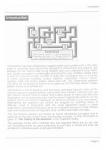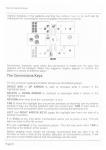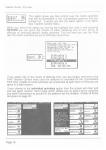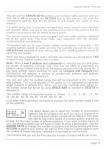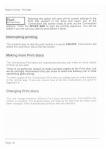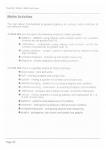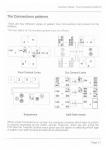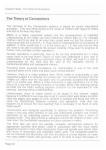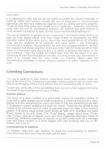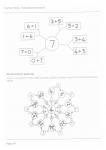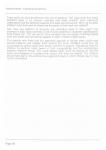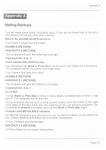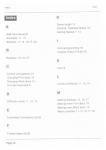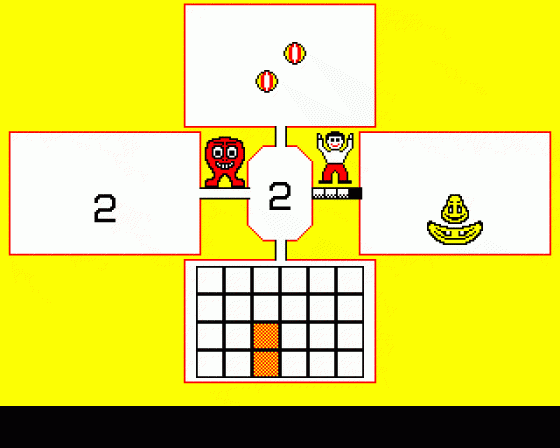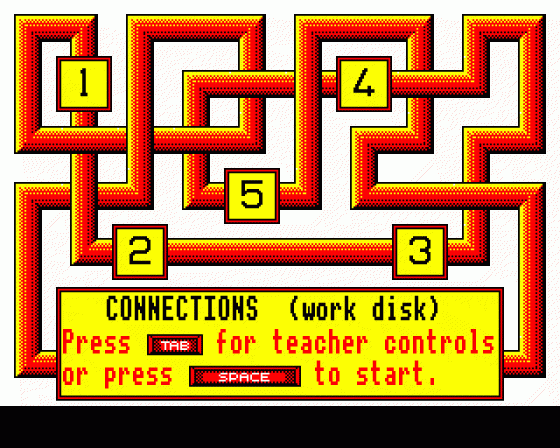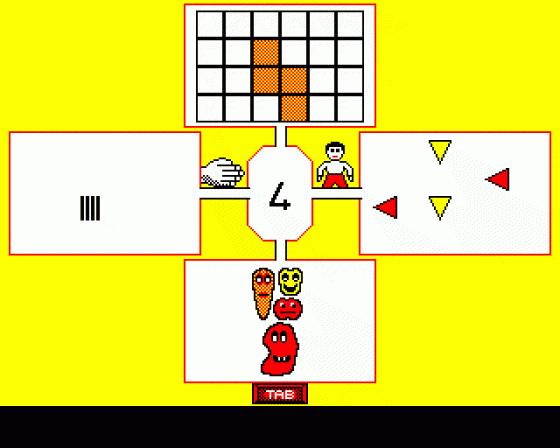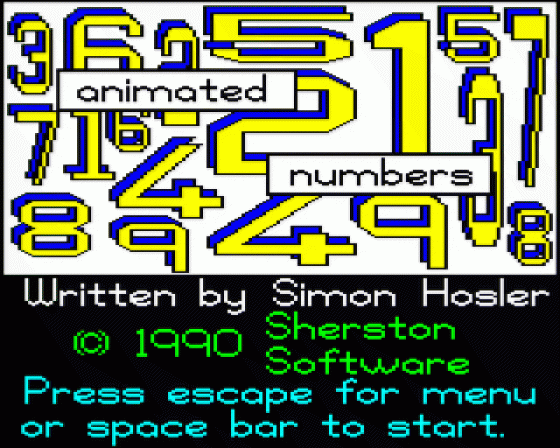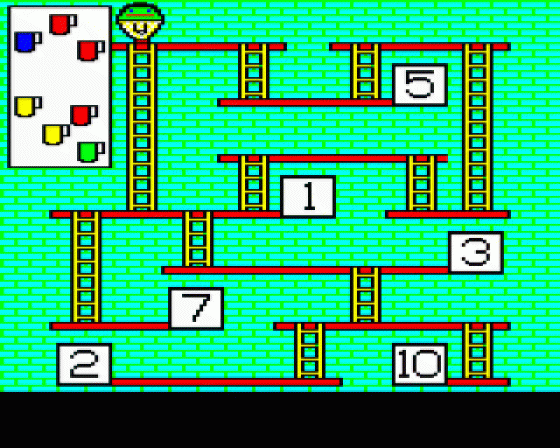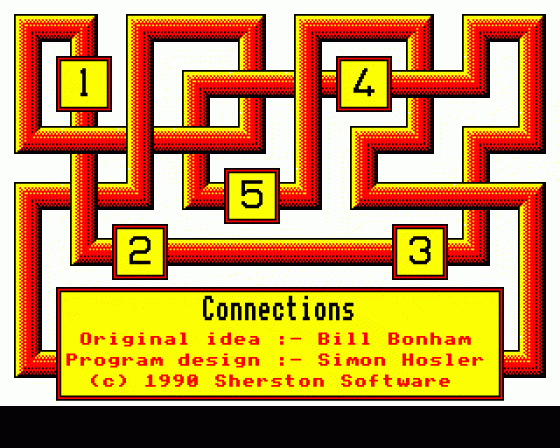
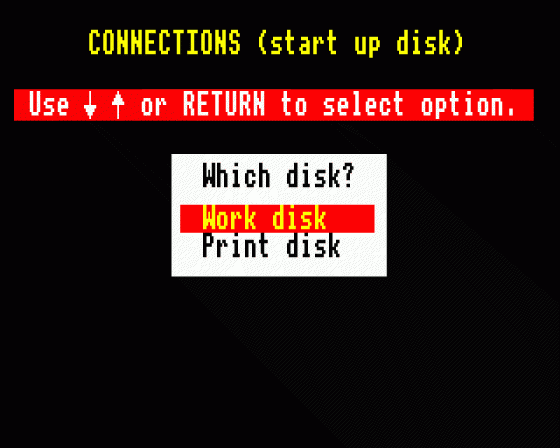
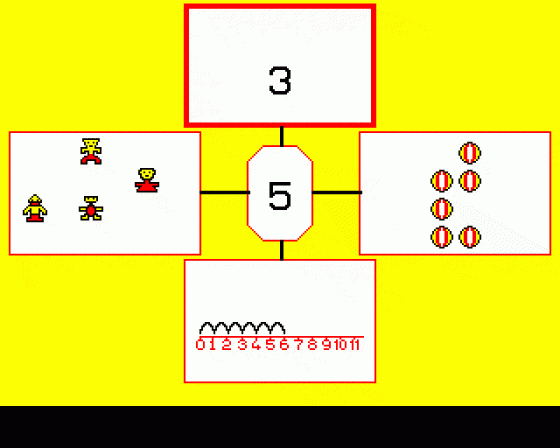
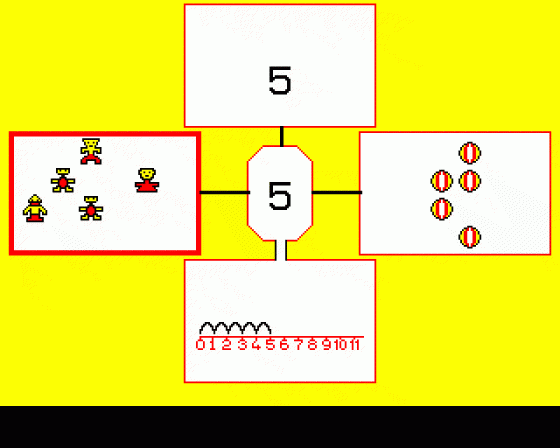
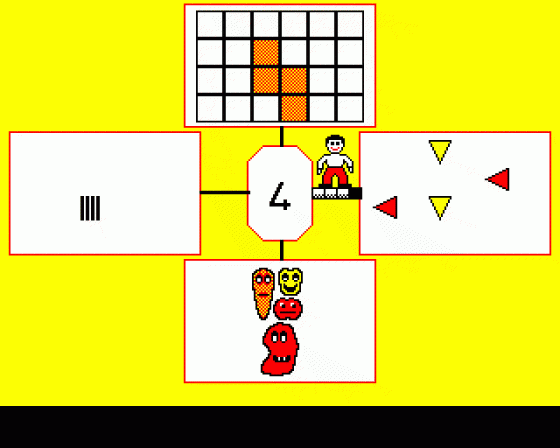
| Genre: | Unknown Genre Type |
| Publisher: | Sherston Software |
| Cover Art Language: | English |
| Machine Compatibility: | BBC Model B |
| Release: | Professionally released on 5.25" Disc |
| Available For: | BBC Model B |
| Compatible Emulators: | BeebEm (PC (Windows)) PcBBC (PC (MS-DOS)) Model B Emulator (PC (Windows)) |
| Original Release Date: | 14th February 1990 |
| Original Release Price: | £14.50 |
| Market Valuation: | £4.00 (How Is This Calculated?) |
| Item Weight: | 98g |
| Box Type: | 5.25" Disc(s) Celophane |
| Author(s): | Simon Hosler & Bill Bonham |
Variant Items
There are 0 other items featuring this same game (that we know about!). Click any of them for their details.
Active Auctions
Closed Auctions
Buy It
Unfortunately no-one is currently selling this item.
Inner Inlay
Auction Price Watch
Worried you're being ripped off? Closing prices on eBay can help you decide what a reasonable price is for a particular item.
Full Instructions
Connections
A new approach to Maths in the Early Years of Schooling.
Introduction
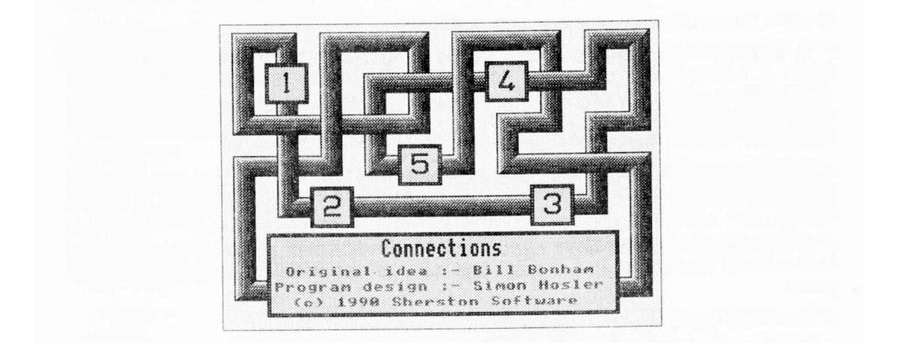 |
Connections has been designed to support maths and number work in the early years of schooling. Built around the concepts of connections and patterns, the package can be used to help young children learn and understand early maths and number concepts in a meaningful and attractive way. Children simply have to alter the contents of each 'window' to make the connections true, in a variety of maths activities including number, addition, subtraction, money, halves, quarters, odds and evens, graphs, place value etc. The Connections patterns can either be completed on screen or on paper as the Print disc allows multiple pattern sheets to be printed out.
Connections is full of graphics and humorous animation that will make all the activities appeal to young children and sustain their interest. Teachers can use the Teacher Control menu to select from a wide choice of maths activities and the program will automatically tailor itself to present appropriate patterns for the children which can either be displayed on screen or printed out as worksheets. Alternatively the teachers can control the program by selecting levels of difficulty. Used in conjunction with the usual equipment found in infant classrooms, Connections will prove to be an invaluable resource to help children learn and understand the all important early number and maths concepts.
The Connections patterns are based on sound educational principles and in particular on the way children learn and develop concepts. Further information is given in 'The Theory of Connections in the Teachers' Notes.
The package comes with a StartUp disc and copyable Work disc so you can use Connections with as many computers as you have in school and even set up discs for individual pupils or groups of children.
The Package Contents
In your Connections package you should find:
- A Connections StartUp Disc - this is protected and you will not be able to make a backup of it. You will need to use it every time you want to get Connections going on one of your computers. The disc is guaranteed for life and will be replaced without question if it corrupts. However if you would like the security of a backup you may purchase one for a small fee.
- Connections Work Disc - you can copy this disc as much as you like. We recommend that you make at least one backup and keep the original in a safe place.
- A Connections Print Disc - you can copy this disc as much as you like. We recommend that you make at least one backup and keep the original in a safe place.
- The Title Card
- Two A3 and Two A4 Concept Keyboard Overlays - we have provided multiple copies of the overlays as Connections can be used on any number of computers within the purchasing establishment.
- A Quick Guide - a teacher's information card.
- A Children's Key Card - a children's information card.
- The Story so far ... - a little cartoon to introduce Connections to the children.
- This Teachers' Book
The Work Disc: Getting Started
Place the StartUp disc in the disc drive. Hold down the SHIFT key, press and release BREAK and then release the SHIFT key. This will automatically start the program.
After the title screen you will be presented with a short menu offering you the choice of going either to a Work disc or a Print disc. Use the ARROW KEYS to highlight Work disc and press RETURN to confirm your selection. You will be asked to replace the StartUp disc with the Connections Work disc. Press RETURN when you have done so.
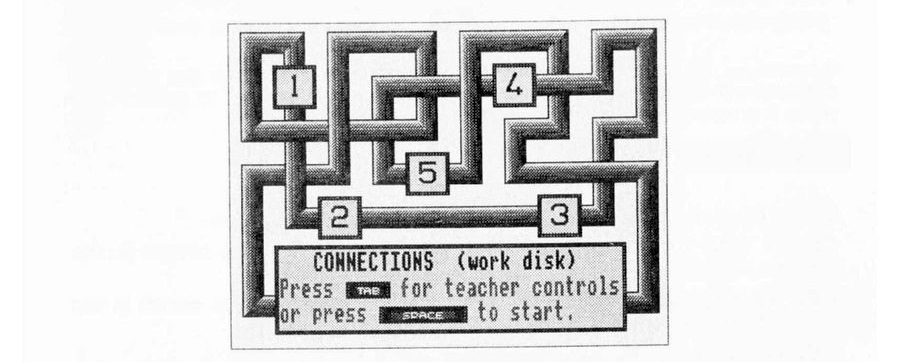 |
The Connections title screen will reappear, but with a choice in the information box at the bottom of the screen. You can simply go straight into Connections by pressing the SPACE BAR and the program will present you with a random selection of the Connections screens at Difficulty level 3. Alternatively you can press TAB for the Teacher Control menu.
The Connections Principle
The principle behind Connections is really quite simple and very easy for children to grasp. All they need to know is that they have to make all the 'connections' true in the patterns they are presented with.
You can embellish this with a little story along the lines that the computer keeps making mistakes in the patterns and that the children have to try and help by making all the 'connections' true to complete the pattern properly.
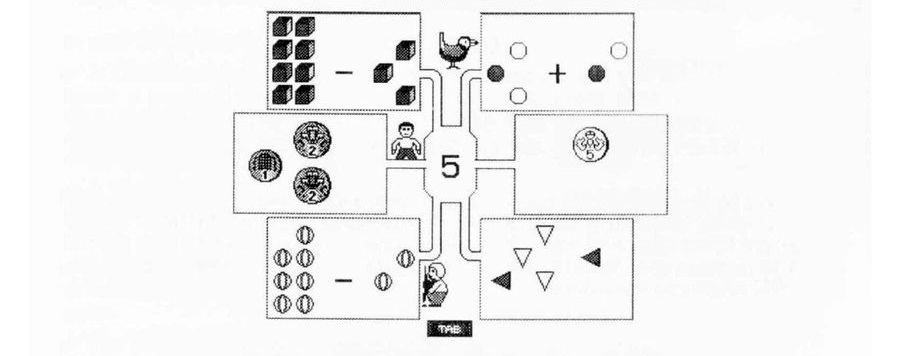 |
Sometimes, however, even when the connection is made true the pipe that appears will be blocked. When this happens helpers appear to unblock the pipes in a variety of different ways!
The Connections Keys
On the computer keyboard children should use the following keys:
SPACE BAR or UP ARROW to 'add' or increase what is shown in the highlighted area.
DELETE or DOWN ARROW to 'subtract' or decrease what is shown in the highlighted area.
RETURN when they think the 'connection' is true.
TAB to move the highlight box around the windows so that they can try another window if they are having problems with the current one. TAB is also used to move onto the next pattern after successfully finishing the previous one.
LEFT and RIGHT ARROW KEYS toggle the highlight box from one side of a window to another.
F to finish at any time when Connections wants you to press a key. This will take you back to the title screen.
P to get a printout of the completed pattern. This will only work when TAB is showing at the bottom of the screen.
Before reading much further we strongly recommend that you take 5 or 10 minutes to have a look at the random selection of Connections screens. It will give you a much better idea of how the package can be used.
Connections And The Concept Keyboard
You can use Connections with a Concept Keyboard simply by plugging it into your computer. There is no need to select a special input option. Once the Concept Keyboard is plugged in then the children can use either the computer keyboard or the Concept Keyboard.
The keys included on the overlay have the same function as described above but you will notice that there are no Por F areas marked for Print or Finish. This was not an oversight on our part, but a deliberate omission. If these were included on the overlay teachers would not have the option of telling children about them or not, as they do with the computer keyboard. Hence the areas for Print and Finish are 'hidden'.
To get a printout the children have to press the nose of the girl that is in the centre between the four main boxes.
To finish their session the children have to press the boy's hand holding the spanner.
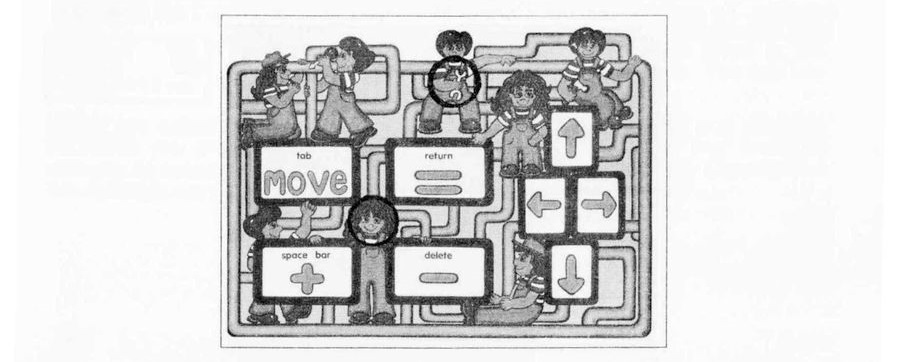 |
We have included two of each of the overlays in the package as Connections can be used on more than one computer at once. If you need further copies of the overlays they are available for a small fee.
Printing A Completed Connections Pattern
When the children have successfully completed a Connections pattern they can either press TAB to move on to the next pattern, or they can press P to get a printout of their completed Connections pattern. You should make sure that a printer is attached and switched on line; however, no harm will occur if they press P without a printer being attached.
On the Concept Keyboard there is no 'key' marked for print, but the children can get printouts of their completed Connections patterns by pressing the nose of the girl in the middle of the four central boxes. See the illustration above.
Please note: The printout from the Work disc supplied is for an Epson or compatible printer only. If you want to produce a colour printout using an Integrex Colour printer you can make a Work disc that will do this by following the instructions in Appendix B. Alternatively we can supply you with an appropriate Connections Work disc for a small fee.
Teacher Control: Work Disc
Connections is very flexible and can be finely controlled by the teacher in a number of ways.
The main Teacher Control Menu gives access to all the adjustments that are possible. To get the Teacher Control Menu you should press TAB when the main Connections screen is showing.
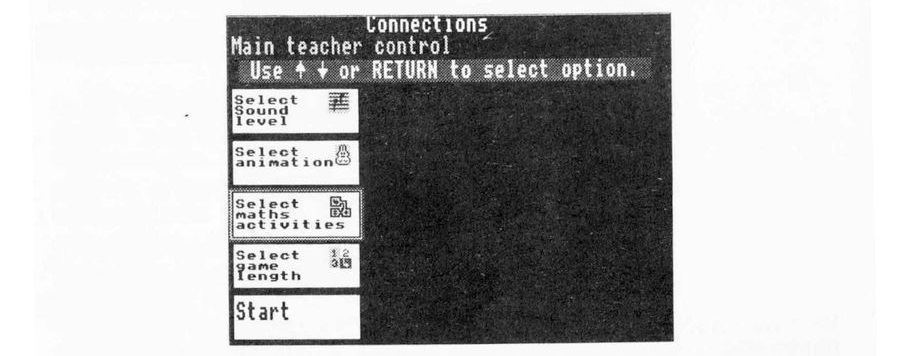 |
In all areas of this menu you should use the ARROW KEYS to move the highlight box over the required option and press RETURN to alter or select it. When you alter one of the Teacher Control options the new values are saved to the Work disc in the drive when you leave Teacher Control. If you have made a number of copies of the Connections Work disc then you can set up Work discs either for individual pupils or groups of pupils.
Select Sound Level
The sound can be set to normal, quiet or off. Use the ARROW KEYS to highlight the selection you require and then press RETURN to confirm your choice. When the program is loaded the very first time, the sound is set to normal. If you alter the sound level the setting will be saved onto the Connections Work disc you are using and will be remembered the next time you use that disc.
Select Animation
You can elect to have the animation turned on or off. This refers to the characters that come along and unblock the connection pipes. These are present simply to provide a fun reward for correct work, but in certain circumstances some teachers may feel happier if they were omitted. To switch the animation off use the ARROW KEYS to select 'off' and press RETURN to confirm your choice.
Whenever the current Work disc is used after this, all the pipes will be clear and the animated characters will not appear. You can turn the animation on again by returning to this option. The first time that you use Connections the animation is set to on.
Select Maths Activities
This Teacher Control option is the one that giies you fine Select
control over the maths activities that will be given in the maths
Connections patterns presented to the children. You can use activities
it in a number of ways.
When you select this option by moving the highlight box over it and pressing RETURN you are given the choice of either selecting one of four levels of difficulty or selecting specific maths activities. When you first use Connections this option is set to Difficulty level three.
 |
If you select one of the levels of difficulty then you are simply returned to the main Teacher Control Menu and the selection is recorded on the Work disc. Details of which activities are presented at each level of difficulty are given in a later section.
If you choose to select individual activities then the screen will clear and you are given another menu page which allows you to select which activities you want Connections to present in the patterns for the children. Details of these are given below.
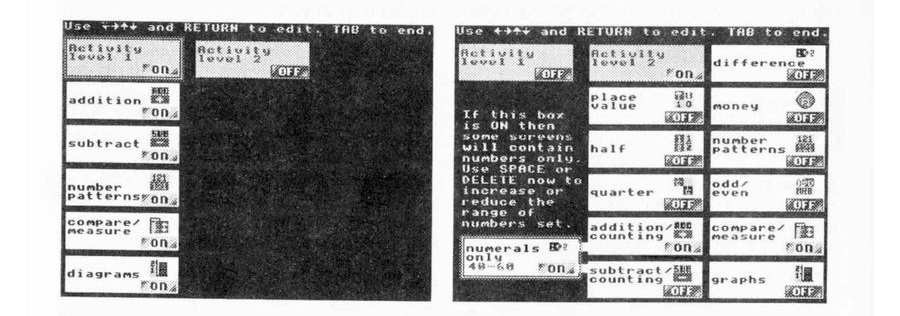 |
You can use the ARROW KEYS to move around these maths activities and turn them on or off by pressing the RETURN key. In this way you can tailor Connections to suit exactly the needs of your children.
It is worth noting that Connections will work best when several maths activities are selected. When only one or two activities are turned on the patterns that the program can produce may be limited to some extent.
You cannot choose to have Level one and Level two maths activities switched on at the same time. You must make your selections from the activities contained within one level only.
Connections will not let you choose certain combinations of activities if the resulting patterns would not work correctly. For example you cannot have only odd and even switched on and nothing else as the resulting patterns would all have only one answer.
When you have selected the maths activities you require you should press TAB to return to the Teacher Control menu screen.
Note: When Level 2 addition and subtraction is selected you are also given the choice of selecting numerals only. This has the effect of presenting the patterns using numbers only and not the various pictures and tally charts etc. If you have another option switched on such as compare and measure then Connections will produce a mixture of number-only patterns and patterns showing measures and comparisons.
You can also alter the number range that will be presented in the 'numerals only' patterns. This is only possible in this option as it is impossible to represent larger numbers in pictorial form on the screen. When you turn the 'numerals only' option on, the number range can be set by using SPACE BAR to increase or DELETE to decrease it.
The number range increases/decreases as follows: 0 - 10,0 - 20, 10 - 30, 20 - 40, 30 - 50, 40 - 60, 50 - 70, 60 - 80, 70 - 90.
In all other maths activities Connections chooses the best number range it can for the activities.
Select Game Length
This option allows you to select the number of Connections patterns that the children will be presented with. Use the ARROW KEYS to highlight the select game length box and press RETURN to confirm your choice. You can then use the ARROW KEYS to highlight the required number of screens to be presented to the children. As with all Teacher Control options once the number of screens has been selected it is recorded on the Connections Work disc.
Start
Selecting this option will save all the current settings to the Work disc present in the drive and return you to the Connections title screen. Press the SPACE BAR for the first set of Connections patterns.
Making More Work Discs
The Connections Work discs are unprotected and you can make as many copies of them as you wish. In this way Connections can be used with as many computers as you have in school. You could also make particular Work discs for individuals or groups of children. To make copies of the Connections Work disc you simply have to make backups in the normal way. If you are unsure how to do this, instructions are given in Appendix A.
Even if you are happy using just one Work disc we strongly recommend that you make at least one backup just in case something goes wrong.
Changing Work Discs
You can change Work discs whenever the Connections title screen is showing. The program does not need to be told that the Work discs have been changed, it will automatically continue with the new Work disc using the values and settings on it.
The Print Disc: Getting Started
Place the StartUp disc in the disc drive. Hold down the SHIFT key, press and release BREAK and then release the SHIFT key. This will automatically start the program.
After the title screen you will be presented with a short menu offering you the choice of going either to a Work disc or a Print disc. Use the ARROW KEYS to highlight Print disc and press RETURN to confirm your selection. You will be asked to replace the StartUp disc with the Connections Print disc. Press RETURN when you have done so.
The Connections title screen will reappear, but with a choice in the information box at the bottom of the screen. You can simply go ahead and print a selection of Connections patterns by pressing the SPACE BAR. Alternatively you can press TAB for the Print Teacher Control menu and tailor the selection of patterns to be printed to suit your children.
Connections On Paper
The principle behind the Connections patterns remains the same when they are presented on paper, but the 'content' of the patterns is altered to suit the activity.
Instead of having to alter the contents of the Connections windows, certain areas are left blank for the children to fill in. For example blank coins would be printed in a money problem so that the children could write the value of the coins in the circles provided.
In every other aspect the Connections patterns on paper are the same as on the computer screen.
Teacher Control: Print Disc
Just like Connections on the screen you can select which activities are presented in the Connections patterns by using the Teacher Control menu.
The Print Teacher Control menu gives access to all the adjustments that are possible. To get the Teacher Control menu you should press TAB when the Connections title screen is showing.
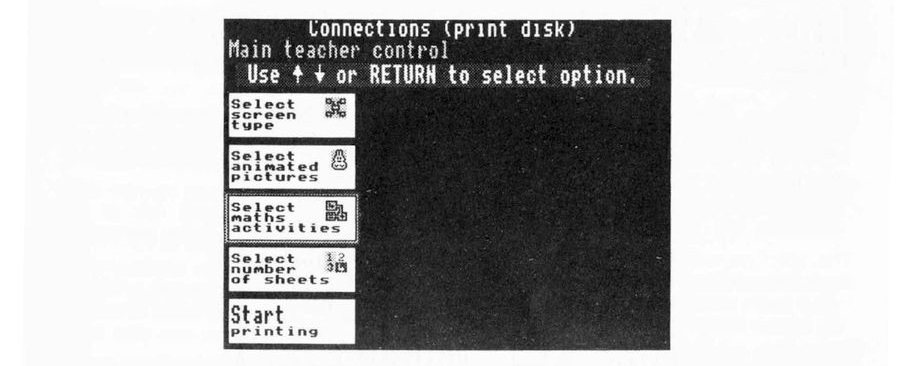 |
Just like the Teacher Control menu on the Work disc you should use the ARROW KEYS to move the highlight box over the required option and press RETURN to alter or select it. When you alter one of the Teacher Control options the new values are saved to the Print disc in the drive when you leave Teacher Control.
Select Screen Type
Select screen type allows you to choose the type of patterns that Connections will print out as worksheets. If you let the computer choose then you will get a mixture of patterns.
Alternatively you can choose to only have central link, sequence or add/take patterns. Examples of the different styles of Connections patterns are given in the Teachers' Notes.
Use the ARROW KEYS to make your selection and then press RETURN to confirm your choice.
Select Animated Pictures
Obviously, you cannot choose to have animation produced animated
on the printouts of the Connections patterns. However, you can choose whether or not you would like to have the characters that help unblock the pipes included on the worksheets for the children to colour in.
To turn the animation characters off use the ARROW KEYS to select 'off' and press RETURN to confirm your choice. Whenever the current Print disc is used after this all worksheets will be printed without the characters. You can change this by returning to this option. The first time you use the Print disc the 'animation' is set to on.
Select Maths Activities
This option gives you fine control over the maths activities that will be presented in the Connections patterns that are printed out. It works just like the same option in the Work disc Teacher Control menu.
When you select this option by moving the highlight box over it and pressing RETURN you are given the choice of either selecting one of four levels of difficulty or selecting specific maths activities. The first time you use the Print disc the maths activities are set to Difficulty Level three.
 |
If you select one of the levels of difficulty then you are simply returned to the Print Teacher Control menu and the selection is recorded on the Connections Print Disc. Details of which activities are presented at each level of difficulty are given in a later section.
If you choose the individual activities option then the screen will clear and you are given another menu page which allows you to select which activities you want Connections to present in the patterns for the children. Details of these are given on page 20.
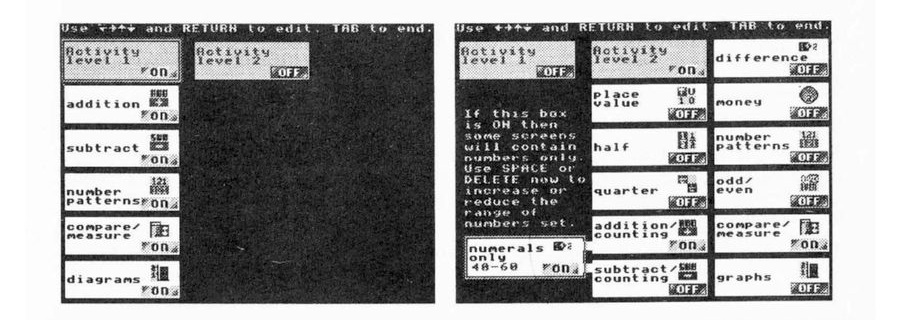 |
You can use the ARROW KEYS to move around these maths activities and turn them on or off by pressing the RETURN key. In this way you can tailor the Connections patterns that will be printed to suit exactly the needs of your children.
It is worth noting that connections will work best when several maths activities are selected. When only one or two activities are turned on the patterns that the program can produce may be limited to some extent.
You cannot choose to have Level one and Level two maths activities switched on at the same time. You must make your selections from the activities contained within one level only.
Connections will not let you choose certain combinations of activities if the resulting patterns would not work correctly. For example you cannot have only odd and even switched on and nothing else as the resulting patterns would all have only one answer.
When you have selected the maths activities you require you should press TAB to return to the Teacher Control menu screen.
Note: When Level 2 addition and subtraction is selected you are also given the choice of selecting numerals only. This has the effect of presenting the patterns using numbers only and not the various pictures and tally charts etc. If you have another option switched on such as compare and measure then Connections will produce a mixture of number-only patterns and patterns showing measures and comparisons.
You can also alter the number range that will be presented in the 'numerals only' patterns. This is only possible in this option as it is impossible to represent larger numbers in pictorial form. When you turn the 'numerals only' option on, the number range can be set by using SPACE BAR to increase or DELETE to decrease it.
The number range increases/decreases as follows:- 0 - 10,0 - 20, 10 - 30, 20 - 40, 30 - 50, 40 - 60, 50 - 70, 60 - 80, 70 - 90.
In all other maths activities Connections chooses the best number range it can for the activities.
Select Number Of Sheets
This option allows you to select the number of Connections patterns that the program will print out up to a maximum of fifteen. Note that each pattern printed will be different. This does not refer to how many copies of a certain pattern that will be printed, but the total number of different patterns. If you want multiple copies of one Connections pattern you will have to resort to using a photocopier. Use the ARROW KEYS to change the number of patterns that will be printed and press RETURN to confirm your choice. As with all Print Teacher Control options once the number of sheets has been selected it is recorded on the Print disc.
The first time that you use the Print disc the number of sheets will be set to five.
Start Printing
Selecting this option will save all the current settings to the Print disc present in the drive and return you to the Connections title screen ready to print out the Connections patterns. Press the SPACE BAR to start the printing sequence. You will be asked if you are sure you want to print before it starts.
Interrupting Printing
The quickest way to stop the print routine is to press ESCAPE. Connections will detect this and return you to the title screen.
Making More Print Discs
The Connections Print discs are unprotected and you can make as many copies of them as you wish.
There is no particular reason to make multiple copies of the Print disc, but we do strongly recommend that you make at least one backup just in case something goes wrong.
To make copies of the Connections Print disc you simply have to make backups in the normal way. If you are unsure how to do this, instructions are given in Appendix A..
Changing Print Discs
You can change between different Print discs whenever the Connections title screen is showing. The program does not need to be told that the discs have been changed, it will automatically continue with the new disc.
Teachers' Notes
Connections is very easy for children to use and the best way of introducing them to the program is simply to let them have a go. However we do recommend that you allow children to try Connections on the computer before you give them any Connections worksheets produced using the Print disc.
Difficulty Levels
The difficulty levels available were included to give teachers an easy way to set Connections to present a selection of patterns for differing abilities. While in general this works well, there are drawbacks. In particular, the number ranges for different activities become limited to the number range set for the difficulty level when perhaps they would be better being set for the individual activities.
If this worries you at all the answer is to use the individual activities to turn specific activities on or off. When you do this Connections will automatically try to choose the best number range for the particular activity.
The activities that the program can choose for each Connections pattern at the four difficulty levels are as follows:
Difficulty level 1 - Number range 0 to 8
Numbers and number lines, counting, numerals, tally charts and sets. •
Difficulty level 2 - Number range 0 to 11
Numbers and number lines, counting, numerals, tally charts, sets, simple addition and subtraction, pictograms and simple graphs.
Difficulty level 3 - Number range 0 to 20
Numbers and number lines, odd and even numbers, halves, quarters, simple place value, addition & subtraction and difference. Money, including addition and subtraction. Simple measures. Pictograms, bar charts and simple line graphs.
Difficulty level 4 - Number range 0 to 29
Numbers, halves, quarters, place value, addition & subtraction and difference. Money, including addition and subtraction. Measures. Pictograms, bar charts and simple line graphs.
Maths Activities
You can adjust Connections to present patterns for various maths activities at two different levels.
At level one you are given the following choice of maths activities:
- addition - addition using objects and numbers where the numbers involved are no greater than 10.
- subtraction - subtraction using objects and numbers where the numbers involved are no greater than 10.
- number patterns - simple patterns represented by objects or one digit numbers
- compare/measure - comparing and simple measuring.
- diagrams - simple diagrams representing numbers.
At level two there is a greater choice of maths activities:
- place value - tens and units.
- half - halving numbers and simple sets.
- quarter - finding a quarter of numbers and simple sets.
- addition/counting - addition & counting of objects and numbers.
- subtract/counting - subtraction & counting of objects and numbers.
- difference - compare two numbers or sets to find the difference.
- money - money problems involving addition and subtraction of 1, 2, 5 and 10 cent coins.
- patterns - patterns and sequences of numbers.
- odd/even - distinguishing between odd and even numbers.
- compare/measures - comparing objects and measuring.
- graphs - pictograms, bar charts and simple line graphs.
The Connections Patterns
There are four different styles of pattern that connections can present to the children.
The four styles of Connections patterns are as follows:
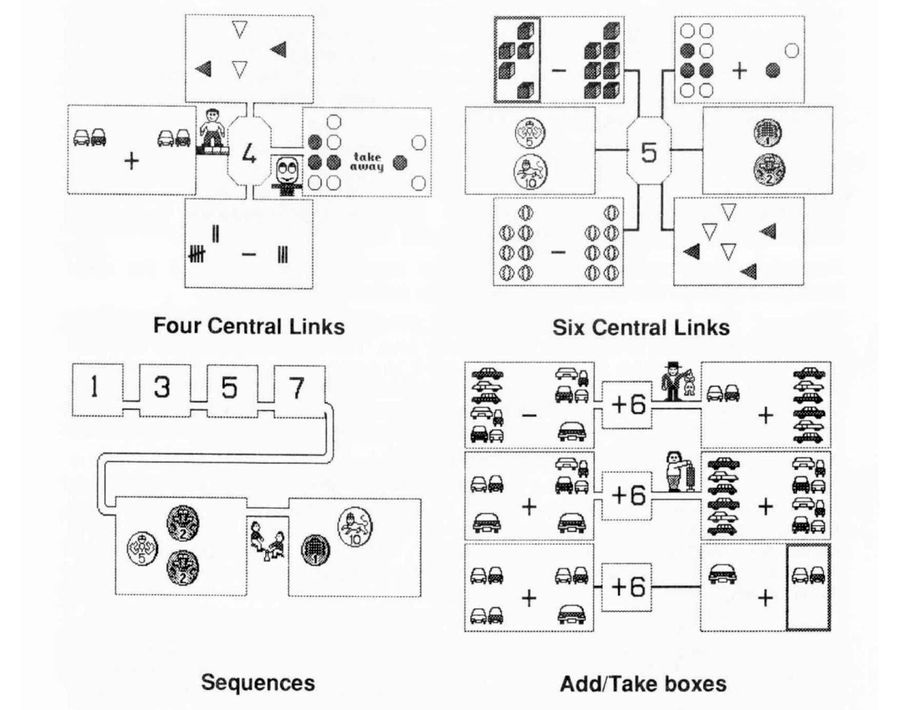 |
When using Connections on screen the computer chooses which type of pattern to present according to the maths activity. However, when you are using the Print disc the Teacher Control menu gives you the option of selecting which type of pattern you want to have printed out as worksheets.
The Theory of Connections
The structure of the Connections patterns is based on sound educational principles. They are linked closely to the needs of children with regard to maths and also to the way they learn.
Maths is a highly sequential subject and the consequences of imperfect understanding at one stage can have disastrous effects later on. For example children need to be able to do more than simply work out that the answer is 5 when faced with the sum of 3 + 2. They need to understand the commutativity of addition, in other words that 3 + 2 is the same as 2 + 3. Not only that but they will need to be able to provide the answer instantly if they want to progress to further, more complex number operations.
Number operations, in particular, have to be not only understood but in many cases have to be over-learnt. Failure to learn and understand a prior task in mathematics, in fact failure to over-learn many of them, will lead to a lack of understanding for the child and the start of the inevitable decline in mathematical ability and subsequent interest.
Providing these essential foundations for mathematics is one of the most important tasks of the infant and lower junior school teacher.
However, there is a major problem here. While maths is undoubtedly a very sequential subject it is certainly not a linear one. The concepts develop from the 'middle out' rather than the 'top down' and it is generally accepted that children learn in a similar way. When a child encounters a new experience he or she tries to fit it into their existing hierarchy of concepts. When new learning cannot be fitted into the child's existing cognitive structure it is the equivalent of 'rote learning', learning without understanding.
Unfortunately, much of maths seems to be taught in this manner, simply because it is difficult to see how else to do it. Hence infant work books are often filled with pages upon pages of sums, all done in isolation and doing very little to show the relationships between numbers and operations. How else can teachers try to ensure the 'over-learning' that is necessary in so much of early maths work?
Connections was designed specifically to address this problem. Presenting maths in this way helps children to see and understand numbers and number operations as an expanding pattern of relationships rather than a series of isolated 'tricks'. They also provide an attractive manner for children to learn, and 'over-learn' the foundations necessary for future success in maths.
The Print disc can print out partially complete Connections patterns for appropriate activities and levels. Used in conjunction with the usual maths equipment found in most infant classrooms these will provide your whole class with hours of meaningful and enjoyable maths work. The completed patterns can be coloured and decorated, can form the basis of a class display, be made into class pattern books and generally used in all sorts of ways that pages of sums can't.
It is important to note that we do not intend to belittle the current methods of teaching maths and number, namely the use of structured or non-structured apparatus and the more traditional aspects such as setting out sums properly. These all have their place and should not be neglected. However, combining these with the use of Connections patterns, we believe, will give children a much sounder foundation to base all their future mathematical learning on.
The use of 'patterns' in general is not a new idea. I first came across them in a book by Tony Buzan called 'Use Your Head' written to accompany the BBC television series of the same name. Here they were presented as an effective study aid for students of all subjects and ages which I can thoroughly recommend to anyone. The justification for their use is based mainly on the fact that research has shown cognitive structures to be multi-dimensional rather than linear. It is therefore fairly obvious that it is better to present information in the same manner - from the middle out rather than from the top down. It is also interesting to note that the patterns emulate, in a very simple way, the manner in which it is thought that the mind works, i.e. thinking based upon the instantaneous formation of actual physical patterns of nerve impulses in the brain.
Extending Connections
The use of patterns to help children understand maths and number need not stop at the end of the Connections package. Indeed patterns can be used very effectively throughout the primary school, and not necessarily only in maths. To give you some idea of the possibilities here are just a few suggestions as to the patterns you could present to your children.
Number stories
The 'story' of a given number is a good class activity for reception infants. A large wall or table display can be made by putting '3' in the central box of a class display and then everything the class can think of that has something to do with '3' illustrated in boxes radiating out from the centre. These can be joined to the central '3' by coloured wool or strips of coloured paper to make a Connections pattern. The boxes could contain such things as 'sets of 3', triangles, the word 'three', books to do with three (The Three Bears), songs about three (Three Little Fishes), pictures of objects cut or torn from magazines that have 'three' of something, children's drawings of objects to do with three such as a birthday cake with three candles or a three legged stool and anything else you or the children can think of.
Commutativity of Addition
Let children make their own patterns to show the commutativity of addition. Once they have done one they will soon get the idea
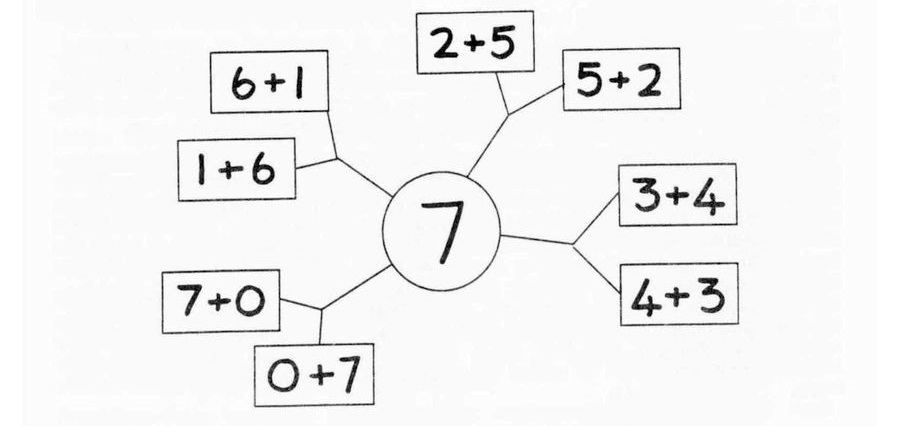 |
Multiplication patterns
These are good to help older primary school children learn and understand their tables
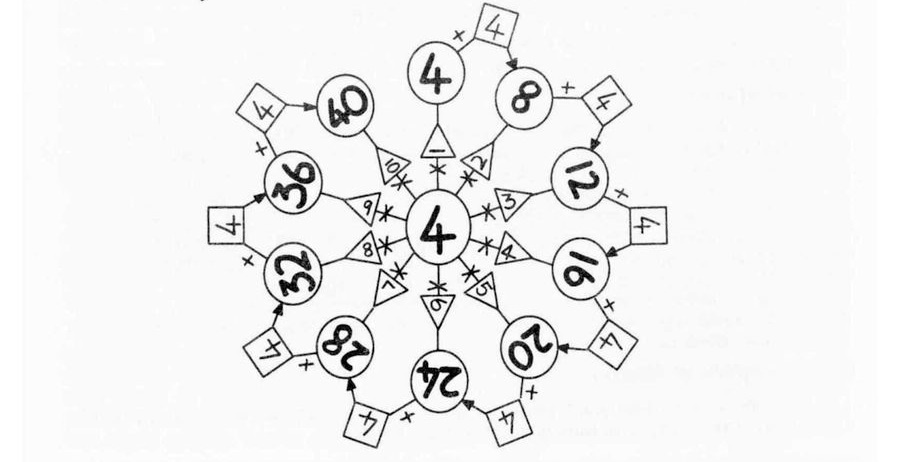 |
Patterns can also be used effectively in language, for example:
Language patterns
Patterns of words to help children learn particular spelling patterns.
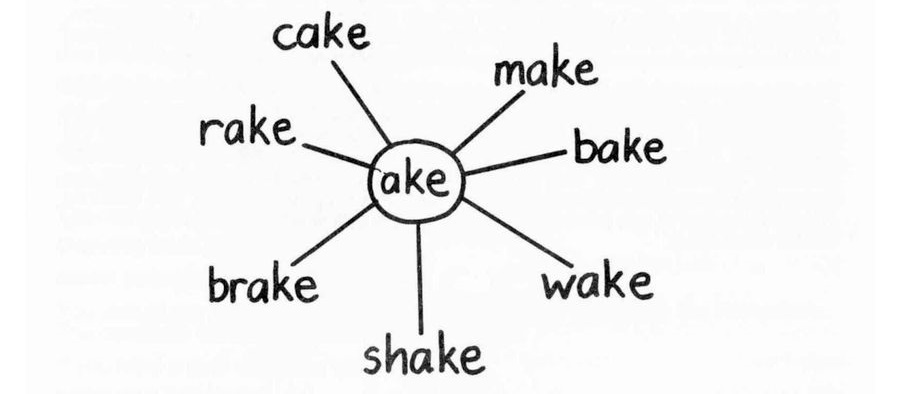 |
This idea can be extended in many ways. Patterns of nouns, adjectives, and adverbs are all attractive and meaningful ways to help children understand grammar.
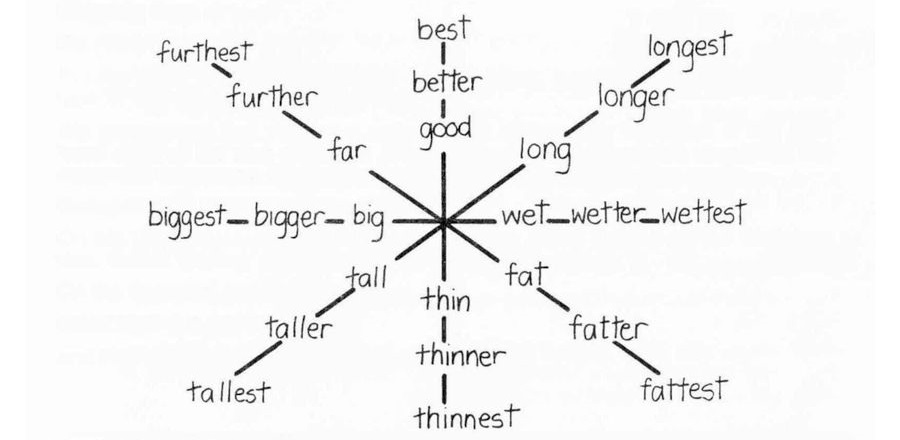 |
Topic work can also benefit from the use of patterns. The 'topic web' that many teachers draw is an obvious example and helps children and teachers!) understand how the different aspects of a topic are connected. Why not let older children draw their own to show how the parts of their topic are related?
Can they use patterns to illustrate any individual parts of their topic? For example a topic about animals could include patterns to illustrate classification, food chains, etc. This can be far more valuable than the pages of writing copied from text books that sometimes appear in older children's topic books.
The teacher who finds that this approach appeals to his/her class could start several patterns and display them around the room. Children could then be encouraged to add to these with words, pictures or objects. This would help the children to become more aware of their surroundings and the relationships between different things. The usual display table could be altered so that the items are displayed in a pattern that shows how they are related. The children should take part in this process by suggesting ways in which things may or may not be connected.
Appendix A: Making Backups
You will need some blank, formatted discs. If you do not know how to format a disc please consult your disc drive manual.
BBC B, B+ and MS128 DFS versions
If you have a single disc drive type:
*ENABLE [RETURN]
*BACKUP 0 0 [RETURN]
The computer will give the following message:
Copying from :0 to :0
Insert source disc and hit a key.
You should put the work or Print disc into the drive and follow the instructions. The computer will tell you when to change discs.
If you have a dual disc drive type:
*ENABLE [RETURN]
*BACKUP 0 1 [RETURN]
The computer will give the following message:
Copying from :0 to :1
Go (Y/N)?
Put the Work or Print disc in drive 0 and a blank, formatted disc in drive 1 and type Y. The computer will do the rest.
We recommend that you put a write protect sticker over the notch of the right hand edge of the disc while you are copying as this will prevent accidents, but remember to remove this before you use the Work or Print disc again.
Compact and MS128 ADFS versions
On MS128 computers you will have to use the ADFS utilities on the Welcome disc. Select 'Backup' and follow the on screen instructions.
On the Compact you should type:
*BACKUP 0 0 [RETURN]
and then follow the on screen instructions.
Appendix B: Making Work/Print discs for the Integrex Colour printer
First you should make a backup of the original Work or Print disc following the instructions in Appendix A. Put the original away and use the backup.
The print routine for the Integrex Colour printer is included on the StartUp disc and you have to copy this onto the backup of the Work or Print disc. The file is called PDUMP.
BBC B, B+ and MS128 DFS versions
If you have a single disc drive type:
*ENABLE [RETURN]
*COPY 0 0 PDUMP [RETURN]
The computer will give the following message:
Copying from 0 to :0
Insert source disc and hit a key
You should put the StartUp disc into the drive and follow the instructions. The computer will tell you when to change discs. The destination disc is the Work or Print disc.
If you have a dual disc drive type:
*ENABLE [RETURN]
*COPY 0 1 PDUMP [RETURN]
The computer will give the following message:
Copying from :0 to :1
Go (Y/N)?
Put the StartUp disc in drive 0 and the Work or Print disc in drive 1 and press Y. The computer will do the rest.
Compact and MS128 ADFS versions
You will have to use the Copyfiles option included on the Welcome disc under ADFS utilities.
Note: When you have copied PDUMP onto the copies of the Work or Print disc they will only work with the Integrex Colour printer and you should make sure that you label them accordingly.
Appendix C: Trouble Shooting
Loading Problems
If the StartUp disc won't load check:
- That you have a 40 track disc for 40 track drives or a 80 track disc for 80 track drives. If your drive is switchable is it set correctly? (Note:- 40 track discs are despatched unless 80 track are specifically requested. 80 track discs are labelled 80 track.)
- If you are using a Master 128 is it configured to DFS? If not type *DISC press RETURN and then !BOOT the disc. Do not try to run the program using the CONVERT program provided with the Master.
- It may be that you have a non-standard DFS which is the cause of the problem. If this is the case we will be happy to give a refund.
- Is your equipment all switched on and connected properly?
- If the disc still doesn't work try it if possible on another computer and disc drive. (Disc drives need a service now and then.)
- If you still have no luck you can either telephone for advice or simply return the disc for replacement. Please make a note of any screen messages etc. so that we can try to identify the problem.
Back Ups
- You should make your own backups of the Work and Print discs.
- The StartUp disc is protected and you will not be able to copy it. If you would like the security of a backup copy these can be purchased from us for a small charge. All our discs come with a lifetime guarantee.
Corrupted Discs
- If any of your original discs corrupt in any way simply return it for a replacement.
Loading
SHIFT-BREAK
Game Credits
Original idea: Bill Bonham
Program Designed and Written by Simon Hosler
Teachers' Book by Bill Bonham
(c) Sherston Software 1990
Connections is a maths package designed to support number and maths work in the early years of schooling.
Programming by Alistair Clarke
Programs and Documentation © Sherston Software 1990
First published in 1990 by Sherston Software, Swan Barton, Sherston, Malmesbury, Wiltshire, SN16 OLH. Telephone 0666 840433. All rights reserved.
Schools are allowed to copy the Work disc, the Print disc and the overlays for use within the purchasing establishment.
With grateful thanks to Charles Hosler and Kay Roberts.
Sherston Software (UK) Swan Barton, Sherston, Malmesbury, Wiltshire, England, SN16 OLH Telephone 0666 840433. Fax 0666 840048. BTGold 72:MAG31653
Sherston Software (Australia) PO Box 418, Nedlands, WA 6009 Telephone (09) 386 4183. Fax. (09) 386 1990
Miscellaneous
This game was mentioned in the following articles:
Screen Designers
The following utilities are also available to allow you to edit the supplied screens of this game:
Cheats
Download
A digital version of this item can be downloaded right here at Everygamegoing (All our downloads are in .zip format).
| Download | What It Contains |
|---|---|
| A digital version of Connections suitable for BeebEm (PC (Windows)), PcBBC (PC (MS-DOS)), Model B Emulator (PC (Windows)) |
Games Like Connections
Report A Problem
We thank you from the bottom of our hearts if you report something wrong on our site. It's the only way we can fix any problems!
You are not currently logged in so your report will be anonymous.
Add Note
Release Country
Change the country to update it. Click outside of this pop-up to cancel.
Scan Of Selected Article
If you auction an item, it will no longer show in the regular shop section of the site.









